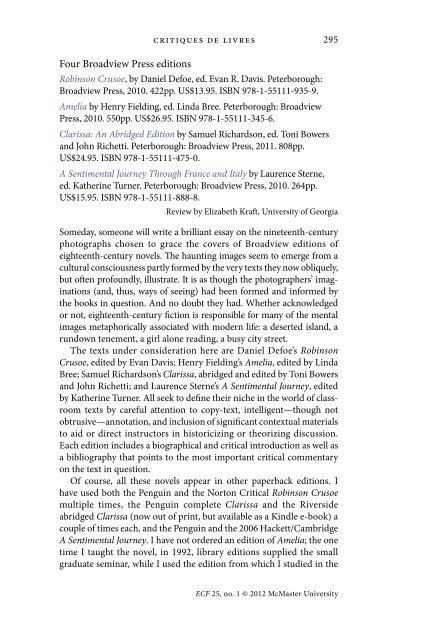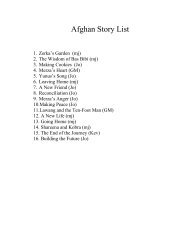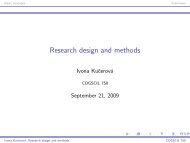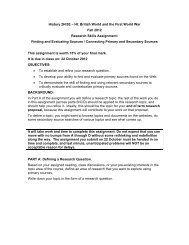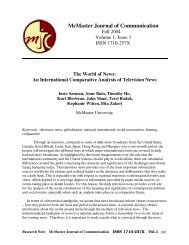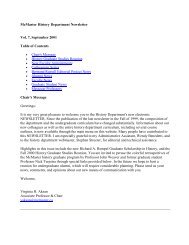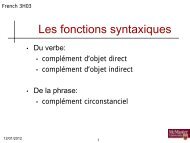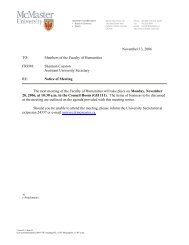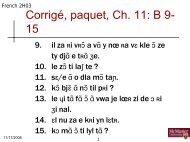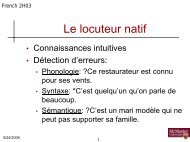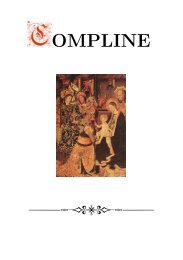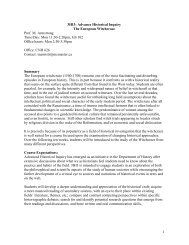Create successful ePaper yourself
Turn your PDF publications into a flip-book with our unique Google optimized e-Paper software.
critiques de livres<br />
295<br />
Four Broadview Press editions<br />
Robinson Crusoe, by Daniel Defoe, ed. Evan R. Davis. Peterborough:<br />
Broadview Press, 2010. 422pp. US$13.95. ISBN 978-1-55111-935-9.<br />
Amelia by Henry Fielding, ed. Linda Bree. Peterborough: Broadview<br />
Press, 2010. 550pp. US$26.95. ISBN 978-1-55111-345-6.<br />
Clarissa: An Abridged Edition by Samuel Richardson, ed. Toni Bowers<br />
and John Richetti. Peterborough: Broadview Press, 2011. 808pp.<br />
US$24.95. ISBN 978-1-55111-475-0.<br />
A Sentimental Journey Through France and Italy by Laurence Sterne,<br />
ed. Katherine Turner. Peterborough: Broadview Press, 2010. 264pp.<br />
US$15.95. ISBN 978-1-55111-888-8.<br />
Review by Elizabeth Kraft, University of Georgia<br />
Someday, someone will write a brilliant essay on the nineteenth-century<br />
photographs chosen to grace the covers of Broadview editions of<br />
eighteenth-century novels. The haunting images seem to emerge from a<br />
cultural consciousness partly formed by the very texts they now oblique ly,<br />
but often profoundly, illustrate. It is as though the pho tographers’ imaginations<br />
(and, thus, ways of seeing) had been formed and informed by<br />
the books in question. And no doubt they had. Whether acknowledged<br />
or not, eighteenth-century fiction is responsible for many of the mental<br />
images metaphorically associated with modern life: a deserted island, a<br />
rundown tenement, a girl alone reading, a busy city street.<br />
The texts under consideration here are Daniel Defoe’s Robinson<br />
Crusoe, edited by Evan Davis; Henry Fielding’s Amelia, edited by Linda<br />
Bree; Samuel Richardson’s Clarissa, abridged and edited by Toni Bowers<br />
and John Richetti; and Laurence Sterne’s A Sentimental Journey, edited<br />
by Katherine Turner. All seek to define their niche in the world of classroom<br />
texts by careful attention to copy-text, intelligent—though not<br />
obtrusive—annotation, and inclusion of significant contextual materials<br />
to aid or direct instructors in historicizing or theorizing discussion.<br />
Each edition includes a biographical and critical introduction as well as<br />
a bibliography that points to the most important critical commentary<br />
on the text in question.<br />
Of course, all these novels appear in other paperback editions. I<br />
have used both the Penguin and the Norton Critical Robinson Crusoe<br />
multiple times, the Penguin complete Clarissa and the Riverside<br />
abridged Clarissa (now out of print, but available as a Kindle e-book) a<br />
couple of times each, and the Penguin and the 2006 Hackett/Cambridge<br />
A Sentimental Journey. I have not ordered an edition of Amelia; the one<br />
time I taught the novel, in 1992, library editions supplied the small<br />
gradu ate seminar, while I used the edition from which I studied in the<br />
ECF 25, no. 1 © 2012 McMaster University
296<br />
reviews<br />
early 1980s—the one-volume Everyman edition. Still, had I needed a<br />
class text, one existed, and still exists, in the Penguin Classics series.<br />
In other words, these Broadview editions are not supplying a bereft<br />
market so much as they are defining a niche within that market, each in<br />
its own way. Davis’s Robinson Crusoe does so quite powerfully. For those,<br />
like me, who teach Defoe’s novel on an almost-yearly basis, the prospect<br />
of adopting a new text is not one of unalloyed delight. My lectures are<br />
coded to the pagination of the two editions I have employed repeatedly.<br />
I have my favorite extra-textual materials, which I assign or supply depending<br />
on which classroom text I am using in the term in question. I<br />
rely on introductory statements that have become as familiar to me as<br />
the novel itself. All that said, the Broadview Robinson Crusoe should be<br />
a “classroom contender” for all who teach this novel. It will be for me.<br />
The appendices in this edition offer a panoply of contextualizing<br />
materials, from castaway narratives to meditations on solitude, from<br />
eighteenth-century economic theory to Defoe’s comments on slavery<br />
and trade, from classic texts on cannibalism to emotive illustrations of<br />
Friday’s rescue. Although the Broadview “context” philosophy seems<br />
in other instances geared to a placing of the text in a specific histor<br />
ical moment, the Robinson Crusoe materials helpfully extend the<br />
moment through Marx and Engels, Cruikshank and Phiz, Wordsworth<br />
and Coleridge. Such an extension is appropriate as this text hit a vital<br />
nerve that has yet to be calmed. I appreciate the inclusion of Charles<br />
Gildon’s wonderful send-up of Robinson Crusoe, but I also value the<br />
materials that will allow me to acknowledge Defoe’s signal achievement<br />
in creating an icon of modern sensibility—the lone survivor, who by<br />
force of will and intensity of faith manages to rebuild a shattered life<br />
that turns out to be even better than the life he lost. That he does so<br />
on the backs of unacknowledged and uncelebrated others is a fact that<br />
Defoe may not highlight, but it is also one he does not hide. The slave<br />
and the worker are inherent and indispensable appendages of the icon<br />
of the survivor, and this edition allows us to explore and interrogate that<br />
fact. We also have, in this edition, the introduction of a new context:<br />
an Arabic fable of island solitude by Ibn Tufayl, a work, according to<br />
Davis, often translated in Defoe’s time. Students eager to explore global<br />
reverberations will appreciate Davis’s deft discussion of the relationship<br />
between this fable and both the narrative of Alexander Selkirk and the<br />
Puritan diaries of Defoe’s time.<br />
The Bowers and Richetti edition also makes a powerful claim to our<br />
attention as it tackles a classroom problem—the length of Clarissa—<br />
with determination to produce a pedagogically manageable reading<br />
experience without sacrificing either the pleasures or the challenges<br />
of the original text. The abridgement that dominated the classroom<br />
ECF 25, no. 1 © 2012 McMaster University
critiques de livres<br />
297<br />
from 1962 until the mid-1980s, the Riverside Clarissa edited by<br />
George Sherburn, was the one I studied and later assigned. One clear<br />
drawback to that edition was the choice to avoid ellipses, so that letters<br />
partially presented were printed as if in whole. Another drawback was<br />
that instead of choosing a copy-text, Sherburn followed a practice of<br />
cobbling together passages from different editions of the text. The result<br />
was a fairly good “read,” but an inadequate version of Richardson’s actual<br />
novel. In 1985, the Penguin paperback edition of the complete Clarissa<br />
(based on the first edition) made abridgement or non-abridgement<br />
an instructor’s choice. Maybe some abridged, but I and my colleagues<br />
tended to seize the opportunity to require full reading. When I assigned<br />
the Penguin paperback (to graduate students only), I expected them to<br />
read the entire text as presented therein. One of my colleagues famously<br />
assigned the Penguin edition for a full reading and added episodes from<br />
the third edition, as well—to undergraduates, who, apparently, loved the<br />
experience (I am not sure how much other reading that class required).<br />
Students today do not read eighteenth-century novels for “story” or<br />
for “sentiment” alone. They are genuinely interested in the production<br />
of texts. They, and all of us, if truth be acknowledged, have finite<br />
temporal resources and ever-increasing demands, so an abridgement<br />
that conveys an adequate sense of the text will be both welcomed and<br />
investigated by students. “What’s left out?” they will inevitably ask.<br />
And, so, it is a virtue of the Broadview edition that Bowers and Richetti<br />
choose to alert readers to missing passages. Granted, these choices<br />
some times lead to a page with what might seem excessive white space<br />
that, theoretically, could result in disruption of reader immersion; but<br />
I believe the modern student appreciates points of pause as well as<br />
indication of where abridgement has occurred. Bowers and Richetti<br />
also employ a modest three asterisks as indication of ellipses, rather<br />
than what could be a disruptive full line.<br />
Bowers and Richetti chose the 1751, third edition of Clarissa for their<br />
copy-text, citing Richardson’s “last revisions” as their primary motivation<br />
for doing so. This decision was likely difficult, as there is a genuine<br />
scholar ly disagreement as to which version of any Richardson text stands<br />
authoritative. Were revisions to editions subsequent to the first the result<br />
of coercion or reconsideration? Do they represent authorial intent or<br />
cultural consensus? Does it matter? In any event, the clear articulation<br />
of a decision, rather than the silent presentation of a compilation, opens<br />
the matter for classroom discussion. And the appendices in the Bowers/<br />
Richetti edition allow further investigation of collaborative practice,<br />
intent, and effect. This is a strong classroom edition that does honour to<br />
the full text even as it makes it possible to teach the novel in a course not<br />
solely devoted to Clarissa. I would consider this edition useful for both<br />
graduate and undergraduate courses.<br />
ECF 25, no. 1 © 2012 McMaster University
298<br />
reviews<br />
For obvious reasons, the editing of any author’s final work presents<br />
fewer challenges in terms of authorial revision. A second edition of<br />
A Sentimental Journey did appear shortly after the first, but Turner,<br />
following the practice of other editors of this text, opts for the first edition<br />
since variants in the second are minor, though many. Bree, too, chooses<br />
the first edition of Amelia as her copy-text, considering and rejecting (as<br />
have others) the posthumous edition that Arthur Murphy claimed (but<br />
did not prove) was based on Fielding’s final thoughts about the novel.<br />
A Sentimental Journey received a distinguished, contextualized treatment<br />
in the 2006 Hackett/Cambridge paperback edition. While that<br />
volume was focused on Sterne and his works, the Broadview text is<br />
designed to foster classroom preoccupation with the history of ideas,<br />
particularly sensibility, and the history of genre, particularly the travel<br />
narrative. Primary materials from John Locke, George Cheyne, David<br />
Hume, Adam Smith, Hannah More, and Sterne himself illuminate the<br />
focus on sensibility. There is an interesting section, as well, on “later<br />
critiques,” which includes remarks by John Wesley, Vicesimus Knox,<br />
and William Wilberforce. The volume concludes with eight illustra tions<br />
of scenes from the novel, all of which underscore a sentimental reading<br />
of the text. Instructors wishing to “pitch” the narrative as a satire are<br />
just as well-served by this material as those who read and teach the text<br />
as a significant and sincere participant in the discourse of sensibility.<br />
Deconstructive readings, especially of the images, can promote fruitful<br />
conversation about the ironies of the text itself.<br />
Of the four novels under consideration here, Fielding’s Amelia<br />
receives perhaps the most cursory contextualizing, which is not entirely<br />
the editor’s fault. The novel, after all, has yet to make its claim to our<br />
sustained attention beyond its status as “favourite child” of one whose<br />
“children” include the winsome Joseph Andrews and the irrepressible<br />
Tom Jones. The other novels treated here produced icons of modern<br />
isolation in the stalwart Robinson, the suffering Clarissa, and the<br />
manic Yorick. Neither Amelia nor Booth is an icon, and, as Bree points<br />
out in her introductory remarks, the novel continues to puzzle us in<br />
ways that it puzzled Fielding’s contemporaries. Although I would have<br />
appreciated the inclusion of more primary material in the appendices<br />
(perhaps some Rambler essays on marriage, selections from Pamela ii,<br />
contemporary reflections on London life, Fielding’s own “Essay on the<br />
Knowledge of the Characters of Men”), Bree’s choice to lightly contextualize<br />
probably does the novel a service in leaving the work open<br />
to classroom construction, at least for the time being. While the other<br />
novels have acquired a rather rich history of classroom discussion (a<br />
history that clearly informed the choices of the editors of those works),<br />
Amelia is not as often taught—and there is less pedagogical lore upon<br />
ECF 25, no. 1 © 2012 McMaster University
critiques de livres<br />
299<br />
which to draw. Therefore, the most useful aspects of this edition are<br />
front loaded. A map of London, in particular, will prove helpful to<br />
students and teachers alike. Much of the appended material addresses<br />
a specific generic concern—the creation of fictional character in the<br />
realistic novel as a philosophical as well as a juridical problem. In<br />
addition, a well-chosen selection from Sarah Fielding’s The History of<br />
the Countess of Dellwyn invites discussion of the relationship between<br />
the sibling novelists, a subject that is certain to intrigue students.<br />
Eighteenth-century fiction tends to be challenging to the twentyfirst-century<br />
student reader; therefore, it is no small virtue that these<br />
books are inviting in appearance and design. From the compelling<br />
cover photographs to the typeface and font size, to the quality of<br />
paper and sturdiness of binding, these books seem built to stand up to<br />
readings and rereadings by students and scholars alike. I recommend<br />
them as viable classroom texts, certainly, but, perhaps as importantly, I<br />
commend them as editions that enhance the pleasure of reading these<br />
works, whether for the first time or for yet another time, whether for<br />
leisure or study, whether to teach or to learn.<br />
Elizabeth Kraft is a professor of English at the University of Georgia. Her<br />
latest book is “Women Novelists and the Ethics of Desire” (2008). She has<br />
recently published articles on Laurence Sterne, Samuel Johnson, and Scottish<br />
novelist John Galt. Her current project is a book-length study of Restoration<br />
courtship comedies and Hollywood comedies of remarriage.<br />
ECF 25, no. 1 © 2012 McMaster University


